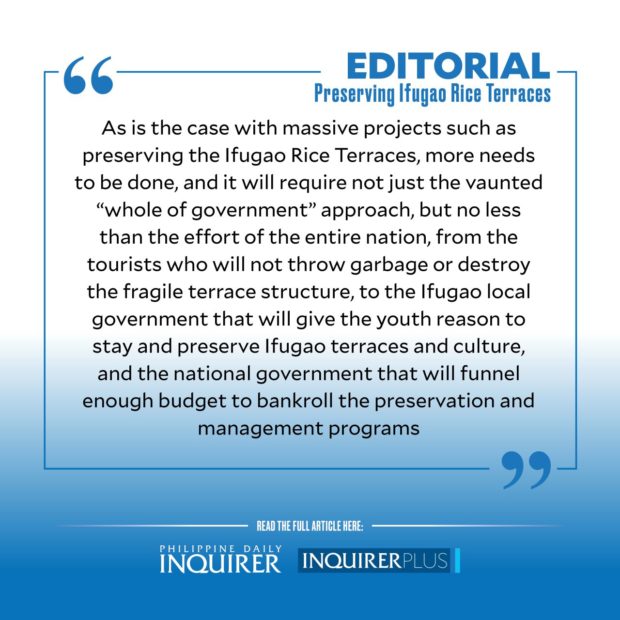Preserving Ifugao Rice Terraces
The majestic Ifugao Rice Terraces were listed in 1995 as a World Heritage Site by the United Nations Educational, Scientific, and Cultural Organization (Unesco), signifying their rightful place among the world’s cultural and natural sites deemed of “outstanding universal value.”
But at the same time, these same terraces that were painstakingly carved by hand from the Cordillera centuries ago by the Ifugao are also among the heritage sites most vulnerable to deterioration and even destruction due to such factors as climate change, urban migration of the young Ifugao, and unregulated tourism.
Article continues after this advertisementIndeed, in 2001, the Ifugao Rice Terraces—comprising the terrace structures in Batad and Bangaan in Banaue, Hungduan, Kiangan, and in Mayoyao described by Unesco as “a living cultural landscape of unparalleled beauty”—were added to the list of heritage sites in danger.
They were only removed in 2012 when the local and national governments were able to show their commitment and determination to protect the five terrace clusters through policy regulations, such as controlled tourism and the formulation of the Rice Terraces Master Plan.
This does not mean, however, that the Ifugao Rice Terraces will not fall back on the dreaded list.
Article continues after this advertisementAs the Unesco noted in its latest monitoring report on the Ifugao Rice Terraces, there remain issues on conserving the site’s “outstanding universal value,” such as the declining interest among the Ifugao youth to work on the land, and the shift from rice growing to more profitable agricultural crops that could lead to the loss of traditional knowledge and practices.
The United Nations body also stressed the heavy toll that climate change has on the Ifugao Rice Terraces, such as increasing storms and typhoons that can become threats and result in major hazards.
“The Disaster Risk Preparedness Plan and climate change adaptation strategies to address increasing climate vulnerability should be implemented as soon as possible,” Unesco said in its 2021 report.
It was, thus, very much welcome news that Canada-based Manulife Financial Corp. and National Geographic Society included the Ifugao Rice Terraces among the 10 global heritage sites that they will help protect from the adverse impact of climate change under the newly launched “Preserving Legacies: A Future for Our Past” project, alongside such cultural treasures as Petra in Jordan and the Angkor Archeological Park in Cambodia.
The Preserving Legacies project seeks to enhance the ability of the communities that live in and rely on these sites for their livelihood to visualize and then act on climate threats.
For example, local weather data can be harnessed to show the threats from flooding, heat, and sea level rise so that local leaders know what specific climate impacts to plan for and when they are likely to experience them.
“By partnering with Manulife and the National Geographic Society, our ambitious approach to addressing this critical issue will not only lead to tangible protection of cultural heritage sites; it will be the game-changers needed to increase access to heritage adaption and transform conservation as a field to meet the challenges of a climate-changed world,” said National Geographic explorer Victoria Herrmann, who will lead the project connected to Manulife’s Impact Agenda.
Significant projects like this raise hopes that the Ifugao Rice Terraces that showcase to the world the depth and breadth of indigenous peoples’ knowledge and their enviable and harmonious relationship with their natural and cultural world will live on for succeeding generations to enjoy and learn from.
Adding to the optimism are encouraging developments noted in the 2021 Unesco review, such as the establishment of interagency mechanisms between the Ifugao Rice Terraces Rehabilitation and Development Council and the Globally Important Agricultural Heritage Systems Sustainable Development Committee of the Food and Agriculture Organization, to address emerging conservation issues, with consideration for the full participation of local communities and other stakeholders.
But as is the case with massive projects such as preserving the Ifugao Rice Terraces, more needs to be done, and it will require not just the vaunted “whole of government” approach, but no less than the effort of the entire nation, from the tourists who will not throw garbage or destroy the fragile terrace structure, to the Ifugao local government that will give the youth reason to stay and preserve Ifugao terraces and culture, and the national government that will funnel enough budget to bankroll the preservation and management programs.
To accomplish all these is a duty not just to future Filipinos, but to the next generations of the global community. A future without the terraces indeed must not come to pass.
As the United Nations said, the deterioration or disappearance of any item of the cultural or natural heritage “constitutes a harmful impoverishment of the heritage of all the nations of the world.”
















